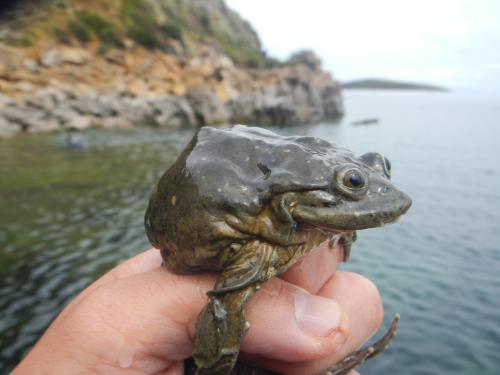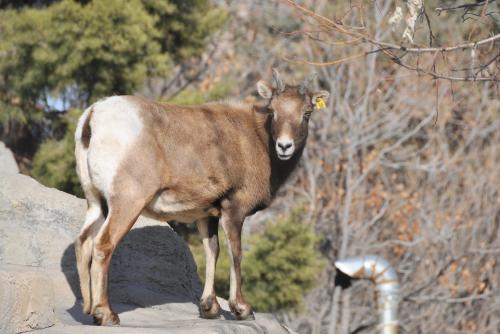For more than 125 years, Denver Zoo has enchanted locals and visitors alike with its diverse animal family, award-winning habitat design and engaging educational experiences. But behind the scenes, this non-profit conservation leader has also been working tirelessly to protect wildlife and wild places, both here in Colorado and around the world. Here are just a few of the ways they’re making a measurable impact — and making their dream of a healthier planet come true.
Defending Colorado Species + Spaces
 If you’ve ever driven past those majestically shaggy bison herds at Genesee Park as you cruise down I-70, you’ve already seen the results of Denver Zoo’s very first conservation project! Every one of these animals is descended from the zoo’s original City Park herd of 18 American bison — which, by 1904, were tragically the last remaining bison in the entire state.
If you’ve ever driven past those majestically shaggy bison herds at Genesee Park as you cruise down I-70, you’ve already seen the results of Denver Zoo’s very first conservation project! Every one of these animals is descended from the zoo’s original City Park herd of 18 American bison — which, by 1904, were tragically the last remaining bison in the entire state.
Zoo officials worked with Yellowstone National Park to establish a healthy breeding herd, eventually donating the animals to Denver Mountain Parks to provide ample roaming grounds for the flourishing herd. To date, Denver Zoo has made reparative donations of 47 bison from this herd to Native American tribes throughout the West. It’s arguably the longest continuous conservation project in Colorado.
The zoo officially launched its global Field Conservation program in 1996. Since then, the organization has participated in more than 600 conservation projects in 62 countries spanning six continents — including important work in their own backyard. Here’s a quick roundup of the stateside species and spaces they’re working to protect:
BOREAL TOAD: In partnership with Colorado Parks and Wildlife, Denver Zoo leads a successful breeding-and-release program working to restore wild populations of this locally endangered species.
AMERICAN PIKA: Along with Rocky Mountain Wild, Denver Zoo studies this tiny rabbit relative — an indicator species that can teach us about the long-term effects of climate change in the Rockies.
BIGHORN SHEEP: Denver Zoo is working with Navajo Nation herding families to identify indigenous solutions to prevent pneumonia transmission from domestic sheep into bighorn.
MOUNTAIN GOAT: In order to discourage wildlife from wandering into Mount Evans trailhead parking lots (where they are likely to encounter humans) Denver Zoo has spread gallons of mountain lion urine.
 ICONIC SPECIES: The zoo is also part of a partnership that’s working to fund and build a wildlife crossing over 1-70 near Vail, with the goal of restoring migration patterns and reducing vehicle-related fatalities.
ICONIC SPECIES: The zoo is also part of a partnership that’s working to fund and build a wildlife crossing over 1-70 near Vail, with the goal of restoring migration patterns and reducing vehicle-related fatalities.
Critically Endangered Species Worldwide
“People think of us as a place to connect with animals, and that’s certainly true,” says Erica Elvove, senior vice president for Conservation Engagement & Impact. “But those one-on-one connections, they’re just a part of our big picture. It’s so important for organizations like ours to also look beyond the individual—and do real groundwork in the wild to save entire species in danger of disappearing forever.”
The zoo prioritizes places and programs where it can make a meaningful impact, like these:
MONGOLIA: For more than 20 years, Denver Zoo has worked in the eastern Gobi steppes, securing more than 300,000 protected acres for iconic endangered species like argali sheep and cinereous vultures.
PERU: Since 2008, the zoo has worked to protect the aquatic habitats of two endangered amphibians — Lake Titicaca and Lake Junín frogs — as well as conducted research on the threatened Chilean flamingo.
VIETNAM: Thanks to the zoo’s work protecting the forest habitat of the critically endangered Tonkin snub-nosed monkey, the population of an important Vietnamese troop has increased by nearly 40 percent.
SOUTH AFRICA: Denver Zoo is part of an international team that has rescued, rehabilitated and released more than 4,000 abandoned African penguin chicks, an endangered species, near Cape Town.
On-Campus Education + Awareness
 According to Elvove, returning to those one-on-one connections may be one part of the zoo’s overall conservation efforts, but they represent a significant part of the organization’s mission. “It’s critical that our guests leave our campus not only with a sense of curiosity about the natural world but also a desire to protect it — along with some concrete ideas about how to do it.”
According to Elvove, returning to those one-on-one connections may be one part of the zoo’s overall conservation efforts, but they represent a significant part of the organization’s mission. “It’s critical that our guests leave our campus not only with a sense of curiosity about the natural world but also a desire to protect it — along with some concrete ideas about how to do it.”
Across the zoo’s 84-acre campus, visitors have countless opportunities to learn how small daily choices can add up to a big difference, from choosing sustainable seafood and responsible palm oil products to learning how to use water or waste for minimum environmental impact. Because, as Elvove says, “We know that saving our planet has to be a group effort. But every monumental effort begins with a single person, so we see each one of our guests as part of the solution.”
Every visit to Denver Zoo supports ALL the amazing work you’ve just read about. Get tickets...get inspired...and make an impact!



